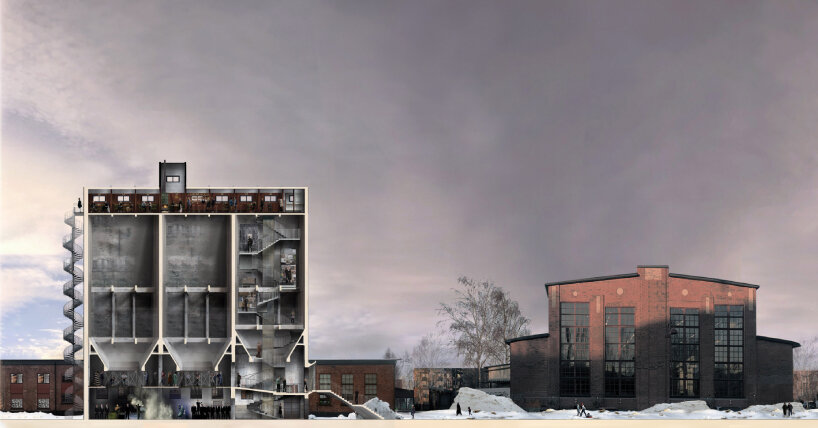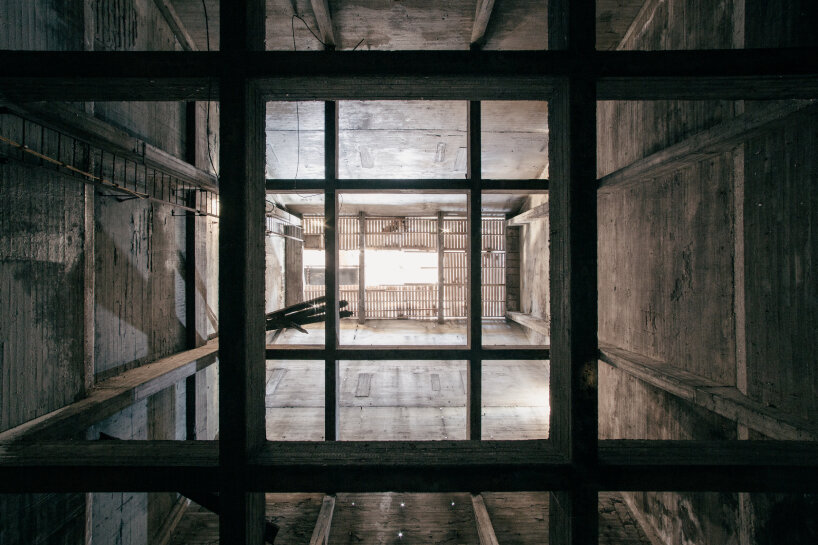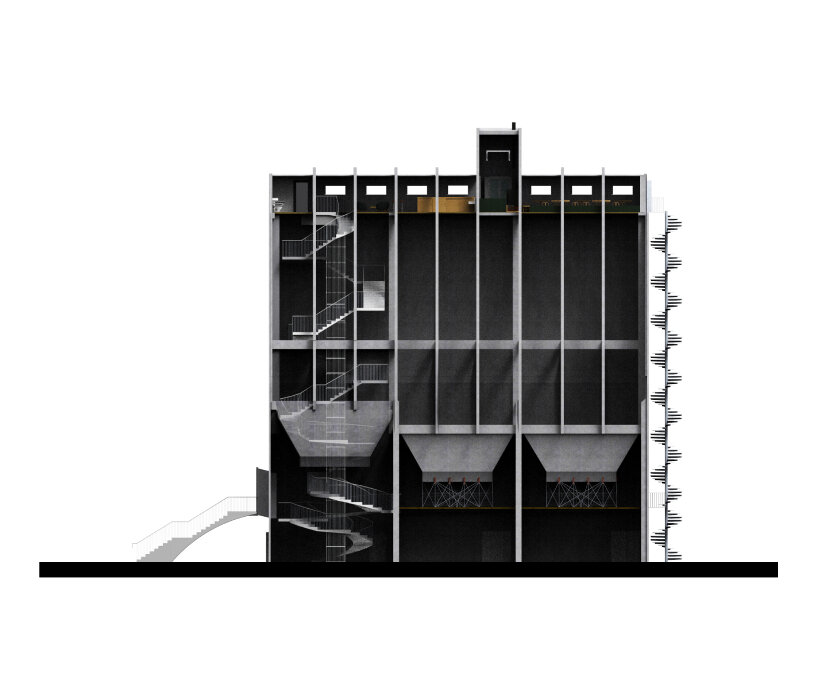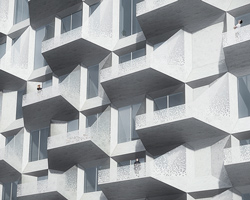Factum Foundation & Skene Catling de la Peña revive AaltoSiilo
Alongside the Factum Foundation and Aalto Foundation, Skene Catling de la Peña is undertaking the ambitious regeneration of Alvar and Aino Aalto’s first industrial structure, built in 1931. Once a sulfite cellulose factory and a silo for storing wood chips, the brutalist relic in northern Finland will soon be revitalized as a research center promoting architectural preservation and reuse. Plans for completion in 2026 are aligned with Oulu’s celebrations for its European Culture Capital year, with the broader community-driven goals for this new chapter already echoed in the ongoing cultural events at the site.
This September, designboom attended the third AaltoSiilo Festival which explored how post-industrial landscapes can be reimagined through art and architecture. The monument was transformed into a stage for an array of audio-visual performances, including a grand acrobatic choreography scaling the concrete facade to the top of the ‘fang’. On this occasion, we spoke with Charlotte Skene Catling — the architect leading the project — about her visions for reinventing the silo from a building designed for processes, to one designed for people, her ‘geoarchaeological’ approach to architectural preservation, and how various design constraints have inspired creative solutions.

all images © Skene Catling de la Peña unless stated otherwise
from derelict brutalist relic to culture and research center
The AaltoSiilo sits at the edge of the Arctic Circle in Oulu and is locally known as ‘The Fang of Toppila’, stirring divisive opinions among the city’s residents and authorities; while some appreciate its distinctively brutal silhouette and architectural heritage, others have been averse to its imposing presence. Recognizing the silo’s significant heritage, which reflects one of the Aaltos’ most innovative, experimental engineering feats, Charlotte Skene Catling’s approach focuses on preserving the architecture while considering the activities and social dynamics that once animated it. The interventions are then centered around stripping the derelict structure ‘back to its purest form’ and utilizing materials and methods for the building’s resurrection that poetically reveal details of its past.
Beyond its architectural ambitions, the project forms a core chapter in Oulu’s plans as the European Capital of Culture in 2026. Through reimagining the silo and its surroundings, the renovation seeks to create a sustained impact on both the local economy and community, turning the Meri Toppila area marked by diverse and transient demographics into a cultural landmark. ‘The goal is to create a place where people want to be through the introduction of spaces for social encounters and economic viability. The building and its exhibitions, and events will be a source of pride, identity, and employment,’ Skene Catling tells designboom. Read our full conversation below.

Alvar and Aino Aalto’s first industrial structure will be turned into a research center
interview with charlotte skene catling
designboom (DB): Can you introduce us to the vision behind the AaltoSiilo project? What inspired you to take on this particular site?
Charlotte Skene Catling (CSK): We discovered by chance that the Silo was up for auction, and it fitted very well with our ‘geoarchaeological’ approach to architecture: looking at place, materials, and social sustainability.
The historic role and place of silos, which had an enormous influence on modernism, adds extra resonance to the project. European architects saw the American grain silos as a liberating vision of the future that offered an antidote to stylized bourgeois constraints. Aalto’s sulfite cellulose factory thrived when exploitation seemed natural and resources infinite. It closed in 1985 leaving behind a ravaged landscape. This led to a thought… Could some of the dark historical context which produced the Silo be looked at as part of its reinvention?

Skene Catling de la Peña teams up with the Factum Foundation and Aalto Foundation
DB: Tying to this idea of reinvention, what are your architectural plans for the structure’s restoration?
CSK: The AaltoSiilo is essentially being stripped back to its purest form, that described in the original architectural drawings. The plans demonstrate the messages: Silo – Don’t tear down: RE-INVENT; Spolia – If you must tear down: RE-USE; Social – Re-invention + Re-use: RE-VITALIZE.
Next to the silo, is the AaltoSiilo Annex, which includes the AaltoSauna, Amphitheater, Social Space, and Research Center. The program of the Research Center weaves public functions and activities, with training spaces, workshops, and offices. A café and flexible exhibition hall welcome visitors through an entrance colonnade. At the heart of the building is a community sauna, where heat generated is recycled throughout the building, optimizing its environmental performance. Offices and residences enclose the upper floors of the courtyard, providing an active frontage.

the interventions are centered around stripping the derelict structure ‘back to its purest form’ | image © Lauri Klemola
DB: Adapting the structure from an industrial silo to a place for the community must have presented several design constraints. How have they inspired creative solutions?
CSK: The AaltoSiilo is an extreme and apparently impossible building: one designed not for people, but for processes; an uninsulated 28-meter-tall concrete building with no windows. As it is Alvar and Aino Aalto’s first industrial building, it is a listed structure, which limits what can be done to it.
Solving the circulation was one of the most challenging aspects. The proposed Tar Bar is at the highest, narrowest point of the structure. Here we repurposed the original bucket conveyor into a lift for people. Equally complex was the insertion of a sculptural staircase through the existing concrete structure. The new route through the building will follow the original industrial process. The path the woodchips once took will form the basis for a new ‘architectural choreography’, beginning at ground level where the trees were processed. It then rises to the top by conveyor lift as the woodchips once did, before filtering down around the structure through a ‘Cabinet of Curiosity’ that is arranged on platforms along the stair route, passing through the concrete hopper, and exiting from the opening that once connected the silo to the next stage of the cellulose production.
The walls are also made of 10-centimeter-thick uninsulated concrete in a structure on the edge of the Arctic Circle where temperatures are far below freezing for much of the year. We are working with an innovative MEP engineer on this.

Charlotte Skene Catling’s ‘geoarchaeological’ approach to architectural preservation leads the project
DB: How are you working with existing materials and introducing new ones?
CSK: A more tangible way of connecting Industrial Cultural Heritage to the present is through what we are calling ‘Material Resonance’: where the materials used in the resurrection of the building have a direct relationship to the building’s former use.
The thin concrete envelope is a key defining characteristic of the architecture. Timber pegs that originally held the shuttering apart were left in situ when the concrete was poured. Over time, these pegs rotted away, leaving behind holes that create beautiful star-like points of light in the space. By repairing these holes with glass rods, we allow the building’s conception, construction, decay, and restoration to be revealed through a single gesture.
Also, when repairing reinforced concrete, the current protocol is to hack away much of the material around the reinforcement bars before sealing and recasting. In the case of the Silo, so much of the original would have to be removed that the nature of the building would be fundamentally changed. A solution is being developed through collaboration between Factum and the manufacturer of Acrylic One — a lightweight and flexible material to allow very ‘light touch’ repairs that keep the original structure largely intact.

solving the circulation with stairs and elevators was one of the most challenging aspects for the architects
Another approach is where we’re using materials that recall the silo’s historic context: Finland’s timber industry, the original function of the cellulose plant, and Oulu’s past as a prime pine tar producer in the 16th century. Pine tar will be used to aromatically seal wooden surfaces and as an alternative to bitumen to waterproof the roof; cellulose will serve as insulation to boost the thermal properties of glazing; and wood chips will be returned to the Silo, but this time as part of a sustainable, radiant heating strategy.
DB: Can you explain what this concept of ‘concrete spolia’ is, and how it aligns with your goals of sustainable construction?
CSK: The annex next to the silo uses what we call ‘concrete spolia’. If concrete buildings must be demolished, we have set out a protocol to utilize their pieces rather than demolishing them to dust. The AaltoSiilo Research Lab is an opportunity to develop this concept, where buildings scheduled for demolition are ‘surgically’ dismantled, and large pieces of them can be reused in new constructions.

the proposed ‘Tar Bar’ is at the highest, narrowest point of the structure
DB: As you’re working closely with the Factum Foundation, what role will technology play?
CSK: Factum Foundation demonstrates what can happen when technology is developed by creative thinkers. The AaltoSiilo Research Center will focus on its applications in the preservation of culture and the environment, with a range of activities involving digital technologies, 3D scanning, Machine Learning (AI), and creative software design.
The project is also based on the same principles that Factum has developed over the past 21 years: local people must gain, both socially and economically, from sustainable preservation. The goal is to create a place where people want to be through the introduction of spaces for social encounters and economic viability. The building and its exhibitions and events will be a source of pride, identity, and employment.

elevation of the new AaltoSiilo with the new Research Lab in the background
DB: How do you see the AaltoSiilo influencing the architectural and cultural landscape of Oulu, especially in the context of its plans for its European Capital of Culture year in 2026?
CSK: Oulu is the perfect size and location at the right time. The largest city in the Arctic North, it’s small enough for us to have close contact and a direct relationship with the Mayor and other key figures in the City’s political, cultural, and academic landscape, while being big enough to become the European Capital of Culture. The AaltoSiilo will be a long-term legacy of this. The ultimate goal is to create meaningful and lasting change, both locally and globally.

the adjacent AaltoSiilo Annex includes the AaltoSauna + Amphitheater, Social Space, and Research Center

the new route through the building will follow the original industrial process


materials used in the resurrection of the building have a direct relationship to the building’s former use.
project info:
name: AaltoSiilo
architect: Skene Catling de la Peña
collaborators: Factum Foundation | @factum_foundation, Aalto Foundation | @alvaraaltofoundation
location: Oulu, Finland




































